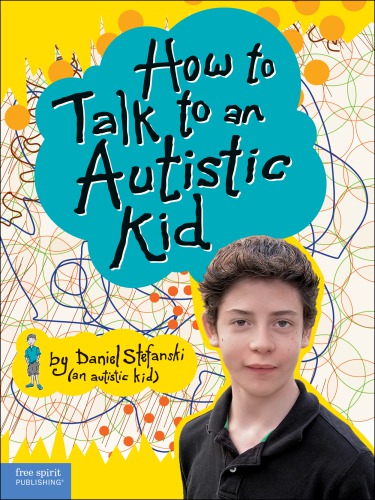
How to Talk to an Autistic Kid
فرمت کتاب
ebook
تاریخ انتشار
2011
Lexile Score
770
Reading Level
3-4
ATOS
4.6
Interest Level
4-8(MG)
نویسنده
Daniel Stefanskiشابک
9781575427393
کتاب های مرتبط
- اطلاعات
- نقد و بررسی
- دیدگاه کاربران
نقد و بررسی

March 21, 2011
As the title suggests, Stefanski, a 14-year-old with autism, has written a book that aims to demystify the disorder for children who may not understand it. Addressing readers kid-to-kid, Stefanski writes, "Not all people with autism are exactly alike, just like not all 'regular' kids or teenagers are exactly alike." Brief chapterlike sections clearly explain the difficulties with communication and social interactions that frequently accompany autism, while urging readers to reach out to and stick up for autistic children. Friendly grayscale cartoons, accented with teal, underscore Stefanski's emphasis on the importance of compassion, patience, and
respect. Ages 8âup.

March 1, 2011
In his first work, Stefanski provides clear, sometimes blunt, often humorous advice for readers on how to interact with autistic classmates. An authority on this topic—he is a 14-year-old boy with autism—he begins by describing autism. Importantly, he gives recognition to the fact that autistic people are a varied group, just like those without autism. "Autism is a disorder that affects how my brain works. (Yes, it does work!)" He describes, using a brief paragraph or two per page, some of the traits many autistic people share: a sensitivity to some kinds of sensory input, a failure to recognize social cues (body language), "getting stuck" on a particular topic, standing too close to others, unusual habits, conversational difficulties, etc. For each trait, he offers down-to-earth suggestions for resolving problems: "Excuse me. Could you step back just a bit? I need a little more space." His insightful, matter-of-fact presentation demystifies behaviors that might confuse or disturb non-autistic classmates. Simple cartoon illustrations in black, gray and two shades of turquoise accompany the text, making it accessible for an even younger listening audience than the older primary/middle-school students it describes. It's a thought-provoking introduction to autism that should be welcome in families with autistic members and an essential purchase for every primary and middle-school classroom. (Nonfiction. 7 & up)
(COPYRIGHT (2011) KIRKUS REVIEWS/NIELSEN BUSINESS MEDIA, INC. ALL RIGHTS RESERVED.)

June 1, 2011
Gr 4-8-Stefanski, 14, a high-functioning "autistic kid," shares his insights and experiences. His voice is straightforward and he has a clear message to convey: "We're all human." The author describes characteristics that make autistic kids different, giving neurotypical children a way to understand and appreciate these differences. He also instructs readers about what they can do and say to normalize interactions. While the book is short and written in language that is easy to understand, it does an impressive job of speaking directly and succinctly about the issues and offering solutions. Simple line drawings depict teens, although there are more boys than girls; this is not unrealistic, given that boys are diagnosed on the autism spectrum four times more often than girls. While the wide variety of people represented on the spectrum is not addressed, this book could be used as a read-aloud, with a teacher or therapist working either with a mixed group of children or those on the spectrum, giving them words to use in social and school settings.-Wendy Smith-D'Arezzo, Loyola College, Baltimore, MD
Copyright 2011 School Library Journal, LLC Used with permission.

























دیدگاه کاربران